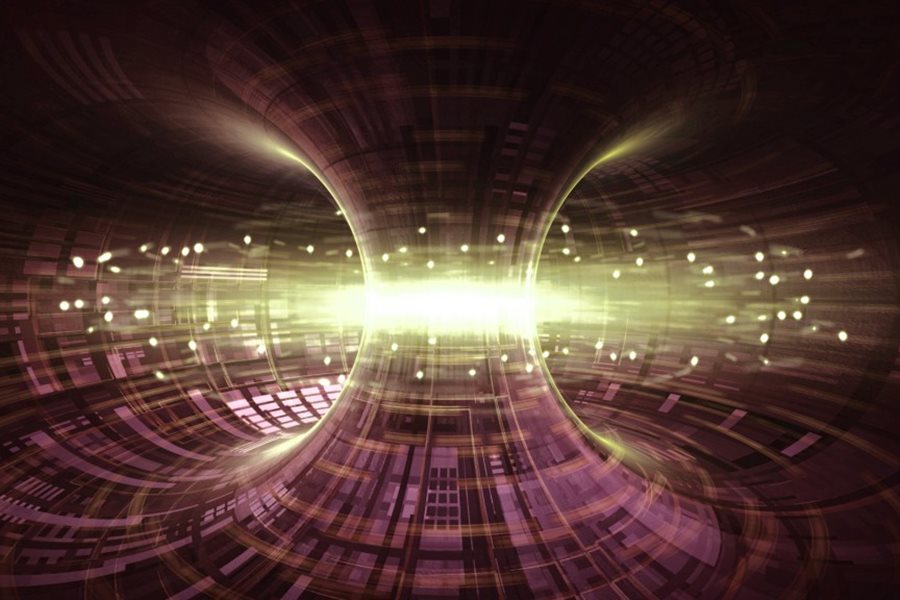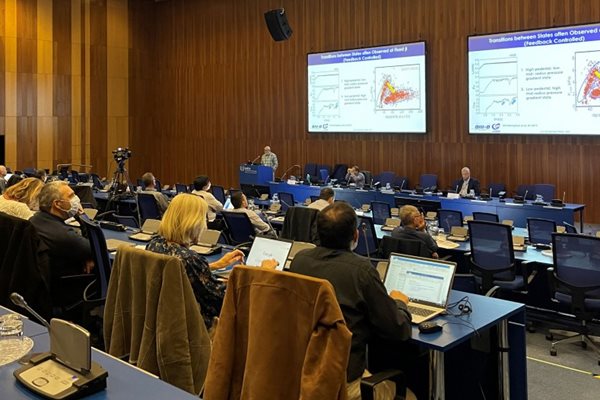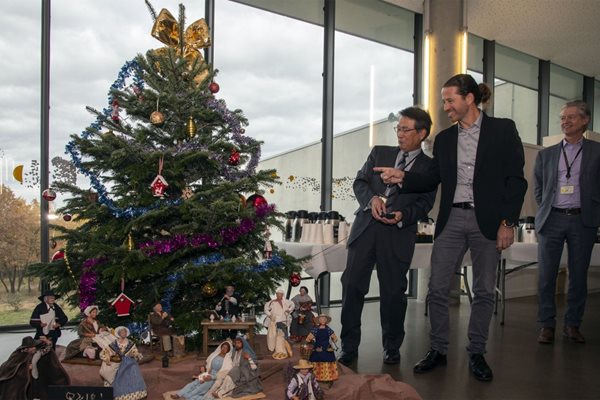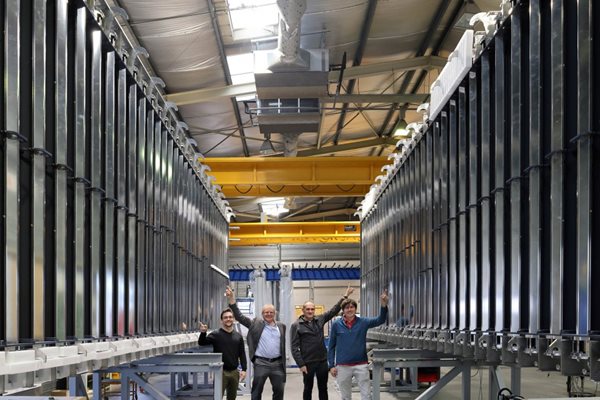
you're currently reading the news digest published from 28 Nov 2022 to 05 Dec 2022
featured2
of-interest1
image1
press10
featured
ITER science | What is burning plasma?
The dream of fusion power depends first and foremost on a self-sustaining fusion reaction, with most of the heating power needed coming from within the reaction itself, rather than from external sources. This is what ITER is all about: trying to create those conditions, in a stable and predictable way, as a starting point towards developing future fusion power stations. 'It's a bit like a barbecue,' says Simon Pinches, ITER's Section Leader for Plasma Modelling & Analysis. 'At first you often need help to get the barbecue really going well—some people use hot air blowers—but once it's started, and the charcoal's really hot, it burns on its own and the barbecue becomes self-heating.' After ten years in Provence, Pinches knows a lot about barbecues—but he knows a great deal more about plasma physics. He did his doctoral thesis (Nonlinear Interaction of Fast Particles with Alfvén Waves in Tokamaks) in the UK back in the 1990s, and followed that with a decade at the Max Planck Institute for Plasma Physics near Munich, Germany. After four years at the European Joint European Torus, and six years at the UK Atomic Energy Authority, he moved to ITER in 2012. 'In numerical terms, what we're trying to do here at ITER is to produce plasmas with a fusion gain (Q) equal to or greater than 10,' says Pinches. 'So that means if we use input heating power of 50 megawatts, we want to see 500 megawatts of fusion power generated.' Of that 500 megawatts, 80 percent of the energy is carried by uncharged neutrons, which fly out of the plasma and heat the tokamak's walls; this is the energy that in future power plants will be harnessed to drive steam turbines. The remaining 20 percent is carried by fast-moving charged alpha particles that cannot escape the plasma. As they collide with other particles they cause the plasma to self-heat, contributing 100 megawatts (or twice the amount provided initially by external sources) to the fusion reaction. 'Before fusion starts occurring, however, we have to get the plasma really, really hot,' says Pinches. 'And we're going to do this in three ways: ohmic heating, neutral particle beam injection, and two sources of high-frequency electromagnetic waves.' All three types of plasma heating have their parallels in everyday households. Ohmic heating, used at the very beginning of the process, relies on the same principles as an electrical toaster or fire, using electrical resistance to generate heat—in this case by running current through the plasma. Neutral beam particle injection works much like the steam attachment on an expresso machine—but on a truly gigantic scale. 'The two beam injectors are each bigger than French TGV train carriages, and will account for 33 of the total 50 megawatts of input power,' explains Pinches. 'Operating at one mega-electron volt each—similar to the sorts of voltages you see on major power grids—the injectors fire neutral particle beams into the plasma. When the particles hit other particles in the tokamak chamber, they pass on their energy and everything heats up.' High-frequency electromagnetic waves work on the same basic principle as a microwave oven, but again on an enormous scale. High-intensity beams of electromagnetic radiation—one for ions and one for electrons, providing tens of megawatts of power each in ITER—bring additional heat to the plasma. Once you have burning plasma, there is then the question of how to manage and control it. 'Once the plasma is self-heating, with two-thirds of the power generated inside the machine and only one-third from outside, it becomes harder to manage,' says Pinches. 'But it's essential that we are able to do so, especially at the scale of ITER. If you lose control of the plasma—for example if it becomes vertically unstable—it can crash into the wall, and that could generate substantial thermal and mechanical loads on the machine's components.' 'That's why we have the ITER disruption mitigation system,' he continues, 'which gives us extra protection to ameliorate the consequences of such events in a number of ways. One of these is to fire champagne-cork-sized pellets of frozen deuterium, neon or argon into the reactor. The pellets radiate away the energy, cooling the plasma and decreasing disruption loads on the machine.' 'Nonetheless, it's obviously much better if we avoid those really big loads altogether,' he goes on to add. 'That's why we'll be starting operations at lower currents and lower magnetic field strengths and powers in the beginning, and gradually working our way up to full power, learning lessons as we go along.' This is important, as scientists predict that there may be non-linear effects with sudden changes of plasma behaviour as the power levels increase, because factors such as turbulence and instabilities in the plasma may be very different when operating at varying input power levels. Of particular concern with the burning plasma are the famous Alfvén waves (named after the only Nobel Laureate in plasma physics, Hannes Alfvén, who won the prize in 1970). The particles and the magnetic field within the tokamak create waveforms which could end up expelling charged alpha particles from the plasma in much the same way that surfers bob up and down on small waves—staying in place until a larger wave carries them along with it, pushing them towards the shore at high speed. 'While that's great if you're a surfer—indeed, it's the whole point—this is obviously an undesirable outcome for our charged alpha particles, which are essential to create and maintain the burning plasma,' explains Pinches. 'If they are expelled from the plasma, we start to lose power, and the whole thing cools down.' Working out how to manage this is a key part of Pinches' job, and he spends a lot of his time working with predictive models, leveraging the power of supercomputing, artificial intelligence and machine learning. 'We are building predictive models for all scenarios via our Integrated Modelling and Analysis Suite (IMAS),' he says. 'This is a suite that's built around a standard data representation with lots of metadata, and it's a portable software, accessible by all ITER Members.' The idea is to have a high-fidelity plasma simulator allowing Pinches and his colleagues—and other scientists around the world—to develop and test different plasma scenarios, and have a better picture of what's going on inside the machine. Detailed simulations are now beginning to happen. 'When we get to First Plasma we can compare the predictions we made, using modelling, with the actual results. We can then tweak our models—long before we get as far as burning plasma and fusion reactions—reworking and retuning them as necessary.' 'That's what I love about fusion, and that's why I've been fascinated by it ever since I was at university,' says Pinches, in closing. 'Fusion is challenging, it's interesting, and it's non-linear. But above all, it's goal-oriented science, with the potential to deliver energy security for all of humankind.'
Fusion world | Mobilizing for long-pulse operation
One of the key operational challenges in the development of fusion energy is the achievement, simultaneously, of high fusion performance and long-pulse operation. This is one of ITER's key missions, and an essential milestone on the road to a fusion power plant that delivers a stable electricity load to the network. In this context, a Technical Meeting on Long-Pulse Operation of Fusion Devices was held at the International Atomic Energy Agency's (IAEA) Headquarters in Vienna, Austria, from 14 to 16 November 2022, to review, discuss and address scientific and engineering issues related to steady-state and long-pulse operation of fusion devices. A measure of fusion plasma performance is power amplification (Q), defined as the ratio of the fusion power produced to the additional heating externally applied to maintain a steady-state. On ITER, high-Q operation will be sustained for a duration of the order of 300-500s (Q=10 milestone) and up to 3000s for Q ≥ 5 operation aiming at steady-state. The ITER Research Plan describes the strategy to achieve these goals. Success relies on solving challenges in an integrated manner addressing both operational and scientific issues (e.g., how to set-up long-pulse operational regimes) and engineering issues (e.g., how all components are actively water-cooled). Controlling fusion plasma for long periods, while gaining experience in steady-state and/or long-pulse operation with active cooling systems that can maintain the plasma-facing components at a stable temperature, is essential for the success of ITER and demonstration fusion power plants. To facilitate the coordination on these challenges, the International Energy Agency (IEA), with IAEA support, established a network in 2020 for Coordination on International Challenges on Long duration Operation, or CICLOP (the wink to Greek mythology might not be accidental, as the Cyclopes were reputed to be supernaturally skilled craftsmen!). The objectives of the CICLOP group are to promote activities, and collect and disseminate information on the physics and engineering issues of long-pulse operation for tokamak and stellarator facilities by sharing best practice, operational procedures, experimental data and simulation programs, and by coordinating experiments between the fusion-related IEA Technology Collaboration Programmes in close cooperation with the IAEA activities in the same field through a series of technical meetings on long-pulse operation of fusion devices. The group is presently chaired by Xavier Litaudon (CEA, France) and co-chaired by Hans-Stephan Bosch (Max-Planck-Institut für Plasmaphysik, Germany) and Tomohiro Morisaki (National Institute for Fusion Science, Japan), with Matteo Barbarino from the IAEA as scientific secretary. As a common activity, the group has already set up a high-level, multi-machine database to address physics and engineering long-pulse operation issues for tokamaks and stellarators. The first Technical Meeting on Long-Pulse Operation of Fusion Devices¹ hosted at the IAEA welcomed more than 50 experts in the field (including up to 10 who were connected remotely) from the ITER Organization, Europe, China, the United States, Korea and Japan—all specialists committed to taking up the challenge of addressing the scientific and engineering issues related to the long-pulse operation of fusion devices. The event brought together junior and senior fusion scientists, plasma physicists (theoreticians, modellers and experimentalists) and engineers in order to cover a broad array of physics and engineering issues. The technical and discussion sessions have focused on the following topics: (i) Long-pulse operation performance and control, (ii) Plasma-wall interactions, exhaust and control, (iii) Heating and current drive and RAMI (Reliability Availability Maintainability Inspectability) aspects for long-pulse operation. The scientific program of the meeting was set up by the CICLOP group. The chairs of the various sessions were selected from the CICLOP group members who provided, in the concluding session on Wednesday 16 November, a high-level summary of the actions and the major issues raised during the meeting that were discussed. All presentations are available from the IAEA website at this address. In particular, the focus of the discussion was on the present physics and technology limits in fusion performance and duration and how to collectively support long-pulse operation development on ITER and beyond. In the first invited lecture at the start of the meeting Sun-Hee KIM, from the ITER Organization, presented ITER long-pulse and steady-state operation candidate scenarios and possible paths to be explored during the ITER Pre-Fusion Power Operation (PFPO) Phase as part of the ITER Research Plan. The ITER Research Plan foresees the exploration of long-pulse operation already starting from the PFPO phase to develop, as far as possible, the scenario and control schemes required but also to make strategic decisions on upgrades of auxiliary heating and current drive systems and other ancillary systems that may be needed prior to long-pulse operation in the Fusion Power Operation (FPO) phase. Identification of operational paths supporting the extrapolation from non-active phases to deuterium-tritium long-pulse and steady-state operations in the FPO phase would be one of the main research activities during the PFPO phase. Much progress in support of this ITER goal was reported from superconducting and actively cooled facilities around the world during the meeting: EAST (China) has reported a world record in pulse duration in tokamaks (1056s with 1.73 gigajoules of injected energy) following major upgrades; KSTAR (Korea) and EAST (China) have reported long pulses in H-modes with a record duration of 310s on EAST; WEST (France) has installed an actively cooled divertor with ITER plasma-facing-units; commissioning started in 2021 and full operation is planned in 2023; Similarly, Wendelstein 7-X (Germany) has installed an actively cooled divertor (2021); commissioning started in 2022 and full operation is planned in 2023; LHD (Japan) has reported on deuterium long-pulse operation and advanced control algorithms to avoid radiative collapses, together with long-pulse operation (2859s) where up to 3.36 gigajoules of energy has been injected. Future plans for long-pulse operation on JT-60SA (Japan) were also presented to demonstrate real-time control capabilities. In addition, experts from ASDEX Upgrade (Germany), DIII-D (USA), QUEST (Japan, Kyushu University), TCV (Switzerland) and the European device JET (United Kingdom) reported efforts on operational scenario development that could be extrapolated (through simulation) to long durations if the engineering limits of the machines could be overcome. Finally, United Kingdom Atomic Energy Authority and General Atomics (USA) experts presented their paths for the development of compact, economical fusion reactors based on advanced concepts, while experts from Oak Ridge National Laboratory (USA) stressed the engineering challenges. To conclude, it was agreed to have a similar event in 2024 to report on the major progress expected in the coming two years in this challenging and active field of research. ¹ The meeting is an extension of the previous IAEA Technical Meeting on Steady State Operation.
of-interest
Tree lighting ceremony
The ITER community gathers on 2 December around the Christmas tree offered by ITER's neighbours and hosts, the town of Saint-Paul-lez-Durance. At the foot of the tree is the Provençal crèche, with the traditional nativity scene plus figures that depict village life such as The Mayor, The Lace-Maker, The Apothecary, and the Shepherd (bowing into the fierce Mistral wind). A tree has been delivered to the ITER Organization by the town of Saint-Paul-lez-Durance for 11 consecutive years—ever since ITER Headquarters opened in 2012. --From left to right: Eisuke Tada, Deputy of the Director-General; Romain Buchaut, Mayor of Saint Paul; and Laban Coblentz, Head of Communication.



